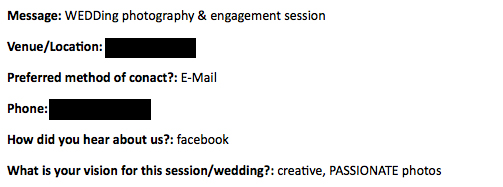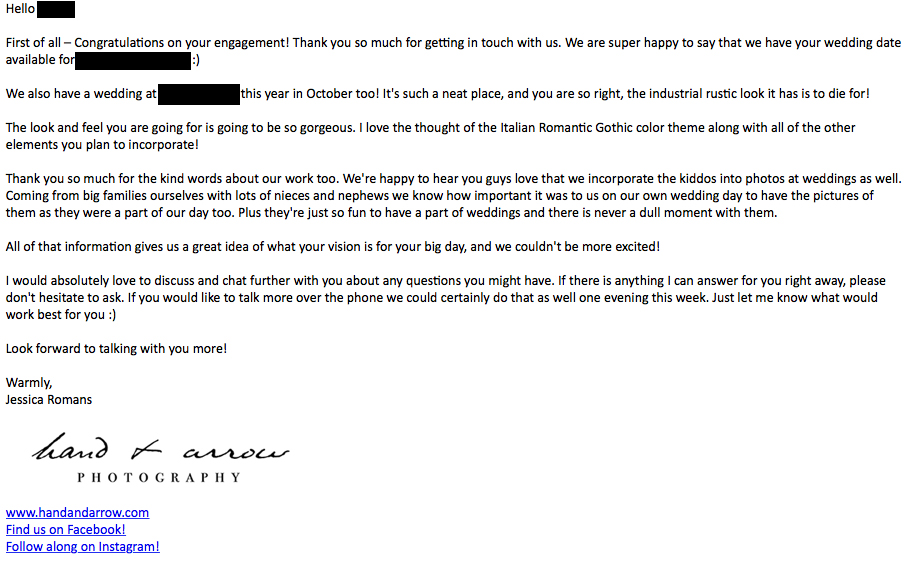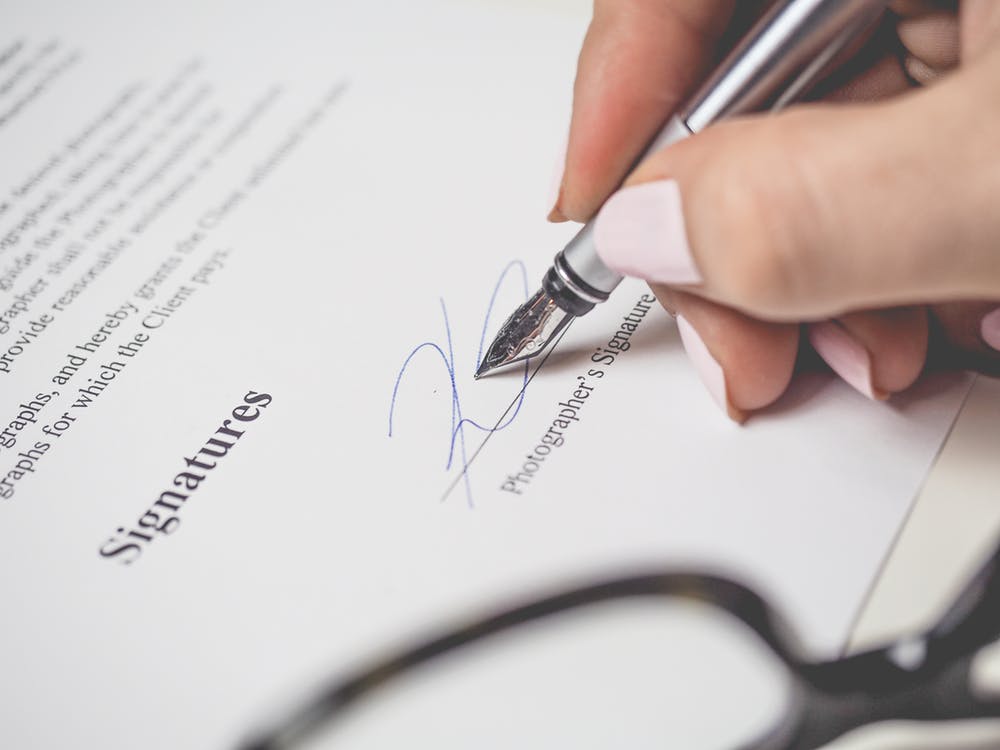Last Updated: February 14th, 2020
We have learned how to make the wedding photography booking process easy.
With 3 years of wedding experience under our belt, we’ve made a lot of refinements to our own workflow that have significantly impacted the number of bookings we are able to make.
The booking process has several key components. It’s important to keep in mind that even after a client has signed and paid your deposit fee, you still have a whole lot of work to do. With clients often booking a wedding a year in advance (or more), it’s critical to keep wow’ing them every step of the way.
In this post, we’ll walk you through a standard wedding photography booking process, and give you guided tips to help you get more bookings under your belt.
1). The Inquiry
 Getting a single wedding photography inquiry can sometimes be the hardest part of this process!
Getting a single wedding photography inquiry can sometimes be the hardest part of this process!
The best things you can do to help get people interested in your photography service is establish a great brand and portfolio. If these are foreign ideas to you, we’ll break it down quick:
- Create your brand. You may already have an established brand (and that’s great!). But, if you don’t, it’s important that you get things like your photography business name, logo, and so on figured out. In our little world, Hand and Arrow Photography is our brand – and you can see our corresponding logo and designs are created with this in mind. While we did all the design work ourselves, you can also outsource this using freelance graphic designers such as those found over on Fiverr.
- Establish an online presence. You will want a website designed to attract new clients. You should also showcase your best work here. In addition, get setup on various social media platforms. Our experience has shown that Instagram tends to be a high performer in bringing in new clients for us.
Through consistent promotion and by showcasing your best work, you will begin to attract an audience of people who will want to book you for their weddings.
Once you start to receive some inquiries, this is where things get really interested.
It’s worth noting: not all inquiries are alike!
We’ve started to recognize the difference between low quality ones that look like they are just being copy/pasted to 100 different photographers and high-quality ones that specifically talk about what they like about our photography and how we can complement the vision we have for their big day.
Example inquiries we’ve received:
Note: We’ve removed private and personally identifiable information from these
Example #1:

Example #2:

Can you tell which ones ended up booking with us?
2). The Follow Up
 Now that you have an inquiry sitting in your inbox, how do you respond?
Now that you have an inquiry sitting in your inbox, how do you respond?
We’ve often puzzled over this question ourselves but have ultimately landed on what is probably the simplest approach you can imagine. Respond authentically.
Instead of having a canned response that you copy/paste for each inquiry, take the time to respond to each inquiry on their own terms. As crazy as it can drive us when we spend 30 minutes putting together an email back, we find that responding in this way allows our prospective client to see that we are actually listening.
The 5 staples of our inquiry responses include:
- Answer any-and-all questions they asked
- If they went into detail about their wedding vision, reference how much you like certain elements. Remember: do this authentically, so don’t fabricate liking something just to make a sale, but if you like the look they are going for – mention it!
- Get excited for the prospective client
- Invite them to setup a meeting
- Let them know you are available to answer any additional questions they may have
If this seems easy, it actually is. We can sometimes get caught up in thinking about how a “business person” would respond, but in practice the best business person tends to be the most relatable.
This seems to be especially true when it comes to booking wedding photography clients. In truth, about 95% of our inquiries come from women (age 18-35). These people tend to be pretty stressed out from wedding planning, and very excited because they are getting married!
We know the experiences first-hand as we went through the process of getting married a few years back – and we try to take this understanding to all the interactions we have with our clients. What we’ve learned through this is a good inquiry response helps eliminate stress and shows the prospective client that the decisions they are making are good ones. This is something that can be refined and mastered by putting empathy into your business practices.
An Important Thing to Note
Sometimes – even a great response to an inquiry will result in the prospective client never following up. Ghosting is real.
To put it bluntly: it sucks.
But, it comes with the territory as a wedding photography business owner. You will need to be prepared to grin-and-bear it when this happens and learn how to move forward.
For us, a lot of these inquiries are from people who are just price shopping and getting in touch with many different photographers. Like we said earlier, it’s often easy for us to recognize these types of inquiries, and we generally put less effort into responding to them than others.
Examples of real life follow ups we’ve sent:
Example #1:
 Example #2:
Example #2:

Can you tell which ones led to further conversation and bookings?
3). The Meeting
 In our experience, the hardest part of the entire wedding photography booking process is getting people to respond and feel excited about moving forward with us. Often, if we get a response back to our follow up, we are pretty close to sealing the deal.
In our experience, the hardest part of the entire wedding photography booking process is getting people to respond and feel excited about moving forward with us. Often, if we get a response back to our follow up, we are pretty close to sealing the deal.
We use meetings (whether on the phone, over Skype, or in person) as a way to get to know each other more. While email is great, it can lack the human element that allows people to feel really comfortable.
If you put yourself in the client’s shoes, it’s easy to understand this as well. We think of it like this: if we were planning a wedding and about to drop thousands of dollars on a photographer, wouldn’t it be nice to at least hear their voice? Maybe it’s just us but…yes…yes it would be nice.
More than this, a meeting allows both parties to ask questions and get answers. It really functions as a two-way interview and is a great way to make sure your working collaboration will be effective.
Our Wedding Photography Booking Process Tips for Having Successful Client Meetings
If meeting in person, only meet at a public location of your choosing.
We used to let prospective clients choose places that were comfortable for them. When working with clients upwards of 3 hours (or more) away, this becomes really taxing and not a great use of time. We’ve since started to move “real life” meetings to a convenient public location close to us. We now just tell clients who want to meet in person we consistently meet at this location, and we’ve never had a problem.
The added bonus? Serious prospective clients will make the effort to go to this location to meet with you.If there is a special request for a different location, we may be accommodating depending on a number of factors such as how interested they seem via email, what package they are looking at, how far they are from us, etc.In our book, it’s important to set the rules, then bend them only if you are approving.
Don’t act like they are your actual paying client just yet.
One of the early mistakes we would make with meetings is sometimes treating them like they have already signed the contract. This comes from a good place as we mean well but can occasionally come across as brash while we are trying to “make a sale”. It’s easy to fall into this trap especially if your livelihood depends on people paying for your photography services.
But, it’s important to keep in mind why people want to meet: to vet you as a professional.
As we’ve said before, aim to be authentic and helpful in your approach to talking with your prospective clients. These things shine through most, and don’t come off as being a pushy sales-person. Or worse: desperate for clients.
Come prepared with questions for them.
While most of the questioning should come from the client towards you, it’s important to show off that you are prepared and interested in them, too.
Asking questions helps you to get more information about the people you are meeting with, as well as more info about their wedding day. A few things we commonly ask again and again include:
These questions allow you to engage with the people you are meeting on a personal and professional level. It also leaves open the door for more discussion about yourself as a person and professional wedding photographer.
- How did you both meet?
- Tell us how you got engaged?
- Are you wanting to have an engagement shoot?
- What attracted you to your wedding venue?
- What attracted you to our style of photography?
Questions are just conversation starters!
Also prepare any online services you use as a part of your workflow to show them off.
When meeting in person, we always bring along our laptop, so we can show off our booking platform and online galleries. This allows us to walk people through what they can expect when it comes to the contract, payment requirements, and how their photos will be delivered to them.
It’s important that you use services that make things simple and easy.
We highly recommend Honeybook for wedding photography booking needs, as well as Pic-Time for gallery delivery.
Don’t pressure, instead explain the value of things.
When walking through your wedding packages and upsell options, it’s important to not pressure people into buying things they don’t want. This mindset does contradict some of the more traditional approaches to in person sales of prints and albums, but it’s something we firmly believe is in the best interest of clients in general.
We suggest mentioning at least some of the add-ons that are available and provide more information as it’s asked for. Refine how you explain these things, and it can serve as a soft sales pitch.
For example, we may mention the ability for a “Day After” session to be added to a wedding photography package. We explain what this is, why it’s cool, and that we’ve actually done one ourselves. To wrap it up, we add booking it with a package would save $50. It’s no pressure, but an option. They can also book one down the line if they are interested.
Sell yourself as a unique wedding photography experience.
And finally, selling yourself.
It’s one of the hardest things to do.
For us, it’s come more easily through time, experience, and a consistent and high quality portfolio of photos we can refer to. The key to selling your service is by highlighting where it differs from other people. You might want to start by writing up a quick one paragraph pitch, then work to refine it so you can speak it naturally. Focus on what you offer, what you’re good at, and what the client would get out of the experience.
Need some self-help and motivation to sell yourself? Give The Subtle Art of Not Giving a F*ck: A Counterintuitive Approach to Living a Good Life a read.
4). The Service Proposal
 Once you get that verbal confirmation that the client is ready to move forward with you, it’s time to seal the deal. Sometimes this will happen at the end of the meeting, but other times the couple may want to go home and talk things over. That is entirely normal and understandable.
Once you get that verbal confirmation that the client is ready to move forward with you, it’s time to seal the deal. Sometimes this will happen at the end of the meeting, but other times the couple may want to go home and talk things over. That is entirely normal and understandable.
You will want to set expectations to move things along such as:
Set a timeline for signing.
We’ve had people commit to us verbally or via email, then sign the contract a month later. We’ll take the business, but it’s also stressful trying to plan for the future with this in the back of our minds. Not to mention, what should be done if we get another inquiry on the same day? This is what has led us to setting a deadline for contract signing.
Usually, we give 7 days for the couple to review and ask questions. If there are no questions or revisions needed, the contract needs to be signed within that week long period. It removes the headache of us asking ourselves “will they or won’t they?” and requires the client to make the commitment formally for our service.
Set a separate timeline for first deposit payment to be made.
If it makes sense for your photography business, you may set things up so the deposit isn’t due right at signing. We actually do this as we understand people may not have money right now, but may have it come the next pay check or two. It’s arbitrary on our end, but we give people two weeks to make the deposit payment after signing.
Offer some flexibility if it makes sense.
People are most attracted to work with professionals who offer flexibility. We’re by no means advocating to be a push over but consider simple ways you can be flexible for your client’s sake.
One way we do this is offer payments plans in 25% installments. Lately, these tend to go most to people booking 1.5-2 years in advance. It just makes sense in this instance, and we make our contract clear that additional payments function as additional non-refundable retainers for our service.
One of the biggest things we have learned is: nothing is actually final until the contract is signed, and your deposit fee paid.
Your goal as a wedding professional should be to streamline this process as much as possible.
While some photographers still go the route of requiring cash/check payments and signing a physical paper contract, this is really just a way to shoot yourself in the foot in the modern day.
We highly recommend a much simpler and easier alternative: Honeybook.
It’s a great platform that allows you to handle sending contracts, signing them, and invoicing for your work. You can read our in depth and helpful review, or head over to Honeybook’s website. They have a free 30-day trial, and if you decide to upgrade to a paid plan, by using our link you can save 50% off your first year’s subscription (a HUGE savings!).
5). The Signing
 Now that you’ve got that contract in front of your new-clients-to-be…it’s time for them to sign. This normally is straightforward enough: they will review the contract, ask you any questions they might have, then sign when they are ready.
Now that you’ve got that contract in front of your new-clients-to-be…it’s time for them to sign. This normally is straightforward enough: they will review the contract, ask you any questions they might have, then sign when they are ready.
This is the easiest part of the entire process. Once you get to this stage, you can feel confident and comfortable in your skills as a wedding photography and businessman (or woman). Just remember, once you get that signature, and see your deposit roll into your bank account, the work is only beginning.
It’s from this stage on that the wedding photography booking process is technically over, but (as you will see if you continue), the work you do for this client will directly translate into your ability to get more work in the future.
As such, the “booking process” really never ends entirely – and that can be a good thing!
6). The Planning
 Now, your communications with your clients will shift towards fulfilling their photography dreams. Some people are open books and want you to take full creative control, while others may end up providing a lot of direction and even Pinterest shot lists.
Now, your communications with your clients will shift towards fulfilling their photography dreams. Some people are open books and want you to take full creative control, while others may end up providing a lot of direction and even Pinterest shot lists.
Managing these expectations is very important.
Every situation is different and should be handled case-by-case, and this is where you can show your true colors. In everything, our suggestion is to aspire to make your client happy – no matter the cost. However, you also need to be real with them when necessary.
For example, if they provide you a family formal shot list of 100 different groupings (it does happen sometimes), you need to be prepared to tell them “this is not going to be possible” OR “we will do what we can to make this work, but we will need to be able to set aside more time than normal to get them all AND it might eat into your personal portrait time.”
One of the key ways we work to preface these conversations (if they need to be had at all), is by sending out a wedding photography questionnaire and putting together a wedding timeline. This is how we collect all of the information we need in the month leading up to the wedding – so we know what to expect, and can set expectations by locking down what time different things will be happening.
Note: Many wedding packages will also include an engagement session. The planning stage can also apply to this – though they tend to be less hectic. Our key for getting great e-session photos is to plan around Golden Hour and an awesome location. It’s nothing crazy, but gets the job done!
If you need help in the planning department, Signature Edit’s has some great resources for purchase that can help you out such as:
- The Wedding Timeline Questionnaire
- The Wedding Photographer Blueprint
- Engagement Style Guide Template
- The Couple’s Candid Posing Guide (really love this one – read our review)
7). The Shoot
 The big day has finally come.
The big day has finally come.
As wedding photographers, we know these events can be pretty anxiety inducing, but the environment is also very fun much of the time!
First and foremost – our goal is to capture photos for the bride & groom. This is why they are paying for us to be there.
Along with this, most of the decisions we make during the day have them in mind. If we notice they are feeling particularly stressed, we won’t always push for a certain shot unless we find it to be really essential. Sometimes, just offering to go out of the reception hall for 10 minutes can be a great way to give them a break from the partying and visiting with friends & family.
Our simple tips for helping the wedding day photography go smoothly:
- Arrive on time. We even suggest coming early if you can to check out the venue and say “hello!” to the bride & groom.
- Stick to the timeline you created. You made it for a reason! Of course, understand sometimes things get out of whack, too. In the words of Captain Barbosa from Pirates of the Caribbean…” It’s more of a guideline.”
- Be nice to everyone. Generally, this should be easy enough, but from time to time people can be frustrating due to a mixture of personality, stress, and alcohol.
- Check in with the bride & groom from time to time. Like we say, it’s the simple things that go the furthest. Check in to make sure they are getting the shots they want or if anything new has come to mind (such as wanting a photo with some distant aunt they forgot would be at the wedding). If things are slower, see if you can grab them a drink, and so on.
- Take control when you need to, otherwise take candids. During family formals – it’s valuable to be able to speak up and give directions. During the reception, it’s easier to take a step back and photograph people in their natural state. For portraits, you can blend these approaches with the bride & groom using simple and great posing prompts.
When the day is over, it’s a wrap!
8). The Editing
 Our post-processing workflow once the wedding day is over looks like this:
Our post-processing workflow once the wedding day is over looks like this:
- Immediately backup the wedding photos to an external hard drive (this is absolutely critical!) – we will get home at 2AM and do this before going to sleep.
- Cull the photos in Photo Mechanic.
- Move your culled photos into Lightroom for editing.
- Put base edits on all of the photos – this can be expedited by using Lightroom presets.
- Continue to cull and refine your photos in Lightroom – you want to provide the best of the best!
- When you’re all done, export the photos.
While getting great wedding photos edits comes as the result of a lot of determination, artistic style, and practice – we can thank presets for helping us get to the edit we want quicker. Over the years, we’ve used a number of different preset options. We currently use our own custom made presets, but would suggest you start out with finding some presets that match what you’d like your photos to look like.
In case you didn’t know, presets provide a good base for your editing work, but you can still make refinements to make the images look exactly how you want them to. Some great preset options we would recommend are: SleekLens, Mastin Labs, Lightagram, and BeArt, and the Genesis Lightroom Collection from Signature Edit’s.
9). The Delivery
 Finally – the day your clients have been waiting for!
Finally – the day your clients have been waiting for!
We know the thrill of receiving a wedding gallery after waiting weeks for it. We’ve been in those same shoes. Your clients will be ecstatic to finally get to relive their wedding day in this way! And you’ll probably be happy to be done editing the photos, too!
While there are different ways photographers deliver their photos, the most modern method comes in the form of an online gallery.
We’ve been experienced with a few different options including Pixieset and Pic-Time.
For the first few years of our business, we used Pixieset (and still would recommend it as it is a great platform). Currently, in year 3, we have migrated over to Pic-Time because of some additional functionality – namely the storefront that enables easier print sales conversions and the ability for clients to put together wedding albums themselves.
No matter what gallery platform you choose, they all tend to have some similar attributes:
- Free trials
- Beautiful (and customizable) layouts
- Security settings
- Download functionality
- Online stores to sell prints, canvas prints, albums, etc.
We’d suggest you give them all a fair shake and choose the one that suites your needs best where price meetings functionality.
10). The Future
 Earlier, we talked about how the wedding photography booking process ends (but not really) when the contract is signed. In practice, it’s short sighted to think of a booking as a one-and-done deal.
Earlier, we talked about how the wedding photography booking process ends (but not really) when the contract is signed. In practice, it’s short sighted to think of a booking as a one-and-done deal.
The longevity of your wedding photography business should really be about bringing in repeat clients and doing so well that your client’s can wait to pass you along to their friends and family getting married down the road. It’s the “wow” factor we mentioned at the start of this post!
While this is a huge area of discussion, a few key things we do to help get some recurring and new business after working with an impressed client include:
- Just check in from time to time. Experienced wedding photographers like ourselves come away from these vendor-client relationships with a fondness for one another. While we try to stay away from becoming “friends” while we are working together, we absolutely welcome this as life goes on. We’ve met too many great people to just want to disown them entirely after the wedding. Shooting that quick email, posting a comment on something they posted on Facebook, and so on are just little ways to stay in touch.
- Post consistently on social media. In particular, Instagram has been really useful for us. Those photos you just delivered? The best shots can go into your portfolio.
- Tag your client(s) on social media, too. One of the fun things is tagging our clients on social media platforms that allow this. For sneak peek shots, this is a no brainer. The reason why this is so useful is because it will make the photo more readily appear in front of the client’s eyes and will also show it off to their friends & family. While you don’t want to overdo this, doing it from time to time into the future can be a great way to reconnect, too!
- Offer discounts on print merchandise periodically. Sometimes, people will go into their wedding galleries, download the pictures, then never look at it again. One way to get them back in there and to entice them to purchase some physical goods is by offering discounts. Through Pic-Time, you can actually set up email blasts that go out to all (or select) clients. A 20% discount on all orders might just bring in a couple hundred bucks that you weren’t expecting.
Like we said, there is so much more than can be done here. It’s just the tip of the iceberg!
So, what do you think? We hope this detail around the wedding photography booking process gives you some real insight on what you can expect. If you have any questions or loose thoughts you’d like to chat about, drop us a line or leave a comment here and we’ll get back to you!